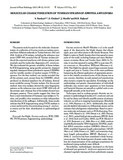Mostrar el registro sencillo del ítem
Molecular characterization of Tunisian strains of Erwinia amylovora
| dc.creator | Dardouri, Sana | es_ES |
| dc.creator | Chehimi, Sonia | es_ES |
| dc.creator | Murillo Martínez, Jesús | es_ES |
| dc.creator | Hajlaoui, Mohamed Rabeh | es_ES |
| dc.date.accessioned | 2017-08-11T09:54:26Z | |
| dc.date.available | 2018-04-01T23:00:12Z | |
| dc.date.issued | 2017 | |
| dc.identifier.issn | 0035-6441 | |
| dc.identifier.uri | https://hdl.handle.net/2454/25081 | |
| dc.description.abstract | The present study focused on the molecular characterization of a collection of Erwinia amylovora isolates recovered from different outbreaks in Tunisia between 2012 and 2014. Analysis of 54 isolates, including the reference type strain CFBP 1430, revealed that all Tunisian isolates produced the expected amplicons with diverse primer pairs routinely used for molecular diagnostics of E. amylovora. We also evaluated the genetic variability of these isolates by PCR fingerprinting, using specific primers for clustered regularly interspaced short palindromic repeats (CRISPRs) and for variable number of tandem repeats (VNTR) sequences. For the first method, our results revealed that all the primers used, except those for CRISPR3, which produced an identical amplicon for all isolates, showed some variability among Tunisian isolates. For the second method, forty-nine isolates showed the same fingerprint patterns as the reference type strain CFBP 1430 with all the primers used, whereas four of the isolates showed very divergent patterns. These results suggest that there has been a main introduction of European-type isolates in Tunisia, and possibly a few mutations or other independent introductions of the pathogen. Additionally, these results indicate that PCR fingerprinting using VNTR markers is a most useful tool for discriminating among E. amylovora strains and for their identification in epidemiological studies. | en |
| dc.format.mimetype | application/pdf | en |
| dc.language.iso | eng | en |
| dc.publisher | Italian Phytopathological Society | en |
| dc.relation.ispartof | Journal of Plant Pathology, vol. 99, n. 2 (2017), p. 331-337 | en |
| dc.rights | Creative Commons Attribution-ShareAlike 4.0 International (CC BY-SA 4.0) | en |
| dc.rights.uri | https://creativecommons.org/licenses/by-sa/4.0/ | |
| dc.subject | Fire blight | en |
| dc.subject | Erwinia amylovora | en |
| dc.subject | PCR | en |
| dc.subject | CRIS- PR | en |
| dc.subject | VNTR primers | en |
| dc.subject | Fingerprinting | en |
| dc.subject | Epidemiology | en |
| dc.title | Molecular characterization of Tunisian strains of Erwinia amylovora | en |
| dc.type | Artículo / Artikulua | es |
| dc.type | info:eu-repo/semantics/article | en |
| dc.contributor.department | Producción Agraria | es_ES |
| dc.contributor.department | Nekazaritza Ekoizpena | eu |
| dc.rights.accessRights | Acceso abierto / Sarbide irekia | es |
| dc.rights.accessRights | info:eu-repo/semantics/openAccess | en |
| dc.identifier.doi | 10.4454/jpp.v99i2.3865 | |
| dc.relation.publisherversion | https://dx.doi.org/10.4454/jpp.v99i2.3865 | |
| dc.type.version | Versión publicada / Argitaratu den bertsioa | es |
| dc.type.version | info:eu-repo/semantics/publishedVersion | en |



